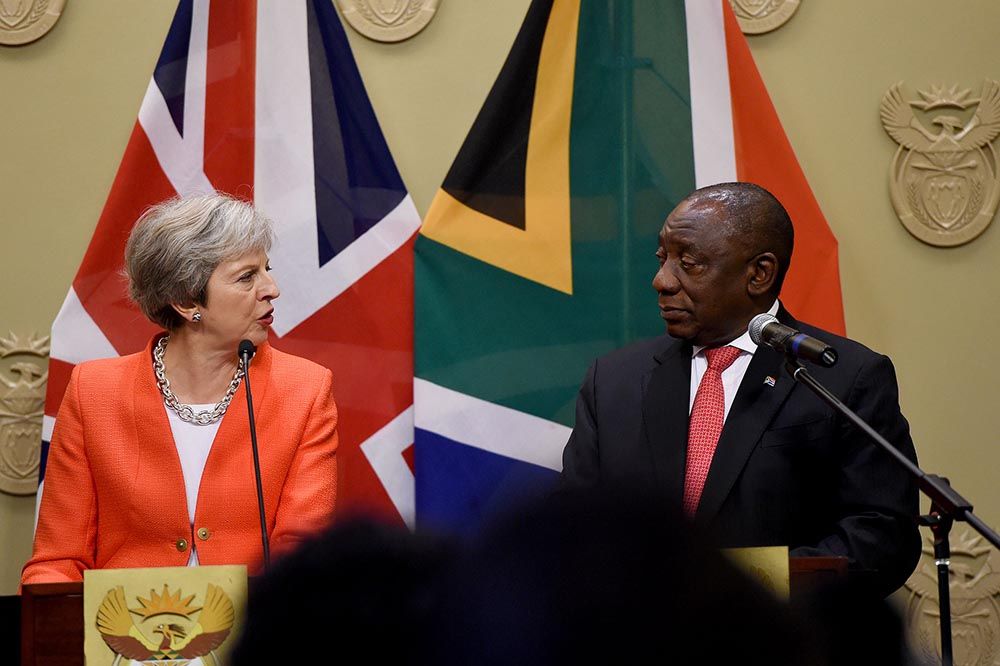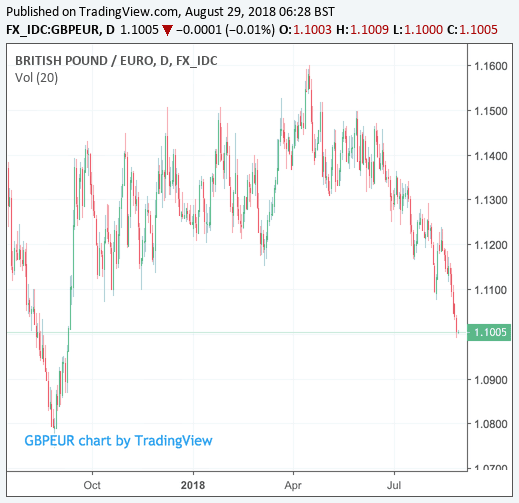The Pound-to-Euro Exchange Rate Could Rally from 1.10 Support

Prime Minister Theresa May and South African President Cyril Ramaphosa. May's latest comments on Brexit keep alive the 'no deal' trade in Sterling. Image © GovernmentZA, reproduced under CC licensing.
- Pound Sterling suffers fresh 11 month lows over course of past 24 hours
- But relief could be found at 1.10 as Pound appears oversold
- 'No deal' Brexit fears continue to grip Sterling
Pound Sterling is seen to be teetering on another key make-or-break level against the Euro as we move through the mid-week session on global foreign exchange markets.
The pair has suffered a relentless bout of selling this August, ensuring the broader sell-off in place since April remains alive. The Pound-to-Euro exchange rate is quoted at 1.1004 on the inter-bank markets at the time of writing, having been as quoted as low as 1.0996 on Tuesday, August 28.
The selling pressures mean the GBP/EUR exchange rate is in the process of printing a series of regular 11-month lows and once 1.0746 is reached will the August 29, 2017 low be breached.
Momentum is clearly pitted against Sterling, but we are told by analysts at one of the UK's most established foreign exchange brokerages that there might be some relief in store around the 1.10 level as buying interest could be found here.
AFEX - an independent international payments and currency management provider established in 1975 - say that while a clear downtrend is observable, the Pound now appears oversold.
"Intermediate GBP downtrends are still in force but this prevailing bearish sequence from 1.1600 or so nonetheless also remains punctuated by regular reaction bounces," says Trevor Charsley, an analyst with AFEX in London.
Indeed, the five-day sell-off we are currently witnessing does appear to be one of the more aggressive sell-offs in this exchange rate's recent history; since April we have only seen two occasions where the sell-off lasts four days.
On both occasions a correction that retraced much of the losses followed.
At current spot-market levels it is likely that those with international money transfer requirements could be seeing rates being offered by their high-street banks in the 1.0620-1.07 region, while independent providers are quoting as high as 1.09.
But, some temporary relief might be in store.
"Another such opportunity to rally may well be presented by nearby 1.1000 area demand," says Charsley.
We note however that the rectracements did ultimately give way to further and deeper sell-offs and this 1.10 support level "may well provide only temporary/psychological support," adds Charsley.
Charsley will only contemplate the end of the current bout of weakness should the Pound-to-Euro exchange rate break back above 1.1250.
"Prices have become over-sold in recent days with little local resistance visible until 1.1150 or so," adds the analyst.
Analyst Robin Wilkin with Lloyds Bank agrees that the exchange rate does appear somewhat oversold at the current juncture.
Commenting on the EUR/GBP exchange rate - the inverse of GBP/EUR - Wilkin notes:
"Momentum warns against getting too bullish. Intra-day momentum is overbought, while both daily and weekly momentum are at regions in which they have previously stalled on multiple occasions."
Advertisement
Get up to 5% more foreign exchange for international payments by using a specialist provider to get closer to the real market rate and avoid the gaping spreads charged by your bank when providing currency. Learn more here
Why the British Pound is under Pressure
Sterling took another dip lower on Tuesday, August 28 with comments made by UK Prime Minister May keeping alive the 'no deal' trade which has kept Sterling under pressure for months now.
May told reporters en route to South Africa that a 'no deal' Brexit would not be "the end of the world". The comments, while not containing any fresh information, did however serve to spur a fresh bout of investor caution regarding the negative prospects posed by a 'no deal' outcome to ongoing negotiations.
"We believe U.K.politicians have talked up the possibility of a No Deal scenario to put pressure on the EU to compromise during the current round of negotiations. The negotiations have increased in scope and intensity in recent weeks and will continue in coming months," says Richard Grace, Chief Currency Strategist and Head of International Economics with Commonwealth Bank of Australia.
May says no-deal Brexit not 'the end of the world' - Sky https://t.co/eyb6VmkUCw pic.twitter.com/FFw7npODh8
— Reuters Top News (@Reuters) August 28, 2018
Yet Sterling has enjoyed better levels against the Dollar of late but when it comes to GBP/USD it must be remembered that the moves in the Dollar are what matter.
For a true reflection of Brexit-related angst, the GBP/EUR exchange rate is regarded as the better indicator.
"EURGBP proved a better gauge of Sterling sentiment being sullied by markets prepping for an outcome in which Britain and Brussels fail to reach a trade deal before Brexit commences in late March. No trade deal would risk subjecting the U.K. economy to growth-sapping uncertainty," says analyst Joe Manimbo with Western Union.
Looking at the calendar for potential near-term catalysts we note month-end flows could drive markets until the weekend in the absence of any major economic releases.
Month-end flows see global money managers rebalance their portfolios against currency moves; the process involves the selling and buying of significant amounts of currency which might move the market. However, it is very difficult to anticipate the moves.
Also note that Brexit talks are ongoing and we will be keeping an eye on Brussels for any updates to progress.
Advertisement
Get up to 5% more foreign exchange for international payments by using a specialist provider to get closer to the real market rate and avoid the gaping spreads charged by your bank when providing currency. Learn more here





